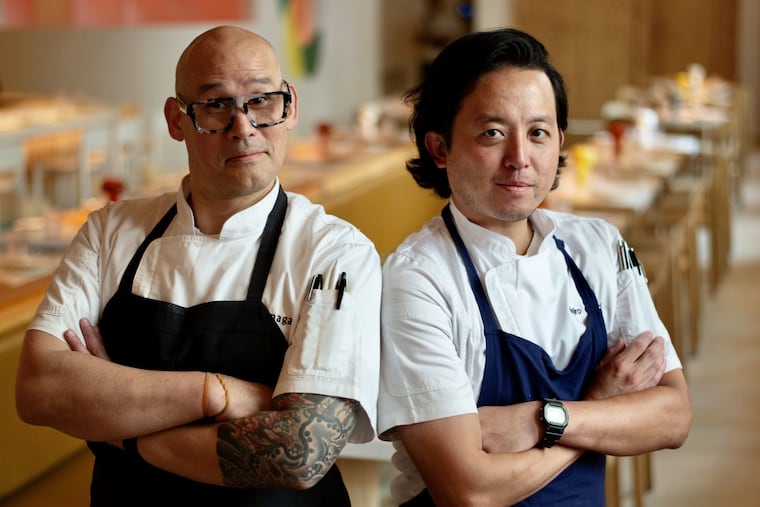Pod is back, and Stephen Starr says he now has the Japanese restaurant he’s always wanted
Sushi specialist Kevin Yanaga and longtime Starr chef Kenjiro Omori are at the helm of the longtime Philadelphia restaurant.

Restaurateur Stephen Starr has restored Pod, a year and a half after he tweaked the longtime Penn campus destination into a Korean-inspired variant called Kpod.
Pod’s menu is now Japanese, with an emphasis on sushi, not the pan-Asian dishes that defined it at its 2000 opening on Sansom Street near 37th. Starr corporate chef Mark Hellyar oversaw the menu development, devising 50 dishes with Kevin Yanaga, the lead sushi chef. Executive chef Kenjiro Omori, whose family owned the Genji restaurants in Philadelphia, has worked for Starr at 10 restaurants since 2014.
Starr calls the new Pod a “grown-up” and more refined version of the original.
The transition began in March, shortly after the departure of Kpod chef Peter Serpico. Signs were swapped out recently.
Most of Kpod’s decor, designed by Richard Stokes, remains — pastels, lacquered wood, and a wavy ceiling. There are still three semiprivate dining “pods” with user-controlled light panels, a holdover from the original. (Pod’s initial look was Y2K retro-modern — high-gloss white epoxy walls, acoustic foam ceilings, concrete floor, dipped rubber chairs, a 30-foot red rubber “barge” serving as lounge furniture, and a robotic sushi conveyor belt.)
It’s open nightly for dinner; lunch will be added Aug. 21 to mark the return of students to University City.
The changeover from Pod to Kpod in early 2022 was set into place by the pandemic. Serpico was a partner with Starr in the edgy, critically acclaimed Serpico on South Street near Sixth. After indoor dining was shut down in March 2020, Starr and Serpico converted it into what they called “a kinda-Korean” takeout and delivery restaurant called Pete’s Place, an homage to Serpico’s native South Korea.
Meanwhile, Pod also was idle. As the pandemic waned and it became clear that Serpico would not reopen, Starr brought chef Serpico on to lead Pod and rebrand it. By all accounts, Kpod did not have the populist appeal to fill a nearly 200-seat restaurant.
Serpico is consulting on restaurant projects around the country and is working with partners on opening a food hall near San Francisco.
Starr said Pod has become the Japanese restaurant he said he wanted 23 years ago. While planning Pod, he also was working on Morimoto, the high-profile Japanese restaurant that opened a year later across town with chef-partner Masaharu Morimoto.
Initially, Pod served sushi and Japanese small plates, Starr said. But quickly, the menu was broadened, lest it steal the thunder of Morimoto. Given the ubiquity of sushi nowadays, Starr has no reservations about owning two Japanese restaurants in the same town.
Yanaga, a Pod alumnus, is back in the Starr fold. Yanaga, previously at Zama, Double Knot, and a former partner in a Japanese restaurant in Fishtown that still bears his name, is working with seasonal seafood brought in from Japan. “The rolls are really creative — not just glazed in a bunch of sauces or anything like that,” Hellyar said.
Omori has a lot of room on his side of the menu: a line of robata grill dishes, rice and noodles, donburi, gyoza, mentaiko spaghetti, Koji miso sea bass, and A5-grade shabu yaki don, a cut of Japanese Hokkaido snow beef sliced paper thin and flash-grilled, served with sukiyaki sauce and an egg.
The cocktail list has been updated, and there’s now a strong sake list, including a house-infused citrus sake.
The three chefs have been bouncing menu ideas off one another. “The other day,” Hellyar said, “we did a sukiyaki pot and Kevin said, ‘This tastes just like what I had growing up,’ and that’s when I knew it would work.”
“Sukiyaki is such an important dish,” Yanaga said. “I think everyone in every Japanese home eats it.”
The idea is to cater to a young, sophisticated crowd. “Stephen wants the food to be fun,” Hellyar said. “What’s wrong with having fun?”